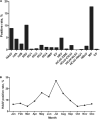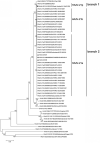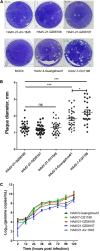Human Adenovirus Subtype 21a Isolates From Children With Severe Lower Respiratory Illness in China
- PMID: 35783397
- PMCID: PMC9244545
- DOI: 10.3389/fmicb.2022.924172
Human Adenovirus Subtype 21a Isolates From Children With Severe Lower Respiratory Illness in China
Abstract
Human adenovirus type 21 (HAdV-21) is an important pathogen associated with acute respiratory infection (ARI), but it was rarely reported and characterized so far. In this study, 151 of 1,704 (8.9%) pediatric patients (≤14 years old) hospitalized with ARI in Guangzhou, China in 2019 were positive for HAdV which was the third most frequently detected pathogen. Two HAdV-21-positive patients presented with severe lower respiratory illness and had similar initial symptoms at onset of illness. Then two HAdV-21 strains were isolated and characterized. The two HAdV-21 strains were sequenced and classified as subtype 21a with genomes closely related to strain BB/201903 found in Bengbu, China in March 2019. Phylogenetic analysis for whole genome and major antigen proteins of global HAdV-21 strains showed that HAdV-21 could be classified into two branches, branch 1 including genotype 21p, branch 2 including all other strains dividing into genotype 21a and 21b. There was no significant difference in the plaque size, or the replication curves between the two HAdV-21a strains and the prototype strain HAdV-21p AV-1645. However, there were five highly variable regions (HVR1, HVR3, HVR4, HVR5, and HVR7) in the hexon protein that varied between two branches. Mice immunized with one branch strain showed 2-4-fold lower neutralizing antibody titers against another branch strain. In summary, this study firstly reported two HAdV-21a infections of children in China, characterized two isolates of HAdV-21a associated with severe lower respiratory illness; our results could be important for understanding the HAdV-21 epidemiology and pathogenic, and for developing HAdV-21 vaccine and drug.
Keywords: human adenovirus type 21; neutralization antigen; severe lower respiratory illness; severe pneumonia; subtype 21a; variation.
Copyright © 2022 Liu, Zhang, Cai, Zhang, Chen, Qiu, Wang, Xu, Gu, Li, Dai, Liu, Zhou and Tian.
Conflict of interest statement
The authors declare that the research was conducted in the absence of any commercial or financial relationships that could be construed as a potential conflict of interest.
Figures






Similar articles
-
Antigenic variability among two subtypes of human adenovirus serotype 7.Virus Genes. 2014 Aug;49(1):22-9. doi: 10.1007/s11262-014-1071-y. Epub 2014 Apr 24. Virus Genes. 2014. PMID: 24760574
-
Molecular Characteristics of Human Adenovirus Type 3 Circulating in Parts of China During 2014-2018.Front Microbiol. 2021 Jun 29;12:688661. doi: 10.3389/fmicb.2021.688661. eCollection 2021. Front Microbiol. 2021. PMID: 34267738 Free PMC article.
-
Molecular Identification and Epidemiological Features of Human Adenoviruses Associated with Acute Respiratory Infections in Hospitalized Children in Southern China, 2012-2013.PLoS One. 2016 May 12;11(5):e0155412. doi: 10.1371/journal.pone.0155412. eCollection 2016. PLoS One. 2016. PMID: 27171486 Free PMC article.
-
Human adenovirus type 8: the major agent of epidemic keratoconjunctivitis (EKC).J Clin Virol. 2014 Dec;61(4):477-86. doi: 10.1016/j.jcv.2014.10.015. Epub 2014 Nov 4. J Clin Virol. 2014. PMID: 25464969 Review.
-
Epidemiology of human adenovirus associated with respiratory infection in southern Brazil.Rev Med Virol. 2021 Jul;31(4):e2189. doi: 10.1002/rmv.2189. Epub 2020 Nov 6. Rev Med Virol. 2021. PMID: 33156553 Review.
References
-
- Chen S., Fan Y., Zhang L., Tian X., Zhou R. (2019). Preliminary Comparison of in vitro Infection Characteristics of Human Adenovirus Causing Acute Respiratory-tract Infection. Chin. J. Virol. 35 741–747.
-
- Cheng Z., Yan Y., Jing S., Li W. G., Chen W. W., Zhang J., et al. (2018). Comparative Genomic Analysis of Re-emergent Human Adenovirus Type 55 Pathogens Associated With Adult Severe Community-Acquired Pneumonia Reveals Conserved Genomes and Capsid Proteins. Front. Microbiol. 9:1180. 10.3389/fmicb.2018.01180 - DOI - PMC - PubMed
LinkOut - more resources
Full Text Sources

